New Zealand built boats have made a huge splash on the Australian market. The toughness and quality of their plate alloy boats makes them very appealing for anglers that love to get offshore into the rough stuff.
The Stabicraft 2050 Super Cab exemplifies the quality, durable and practical New Zealand way of making boats. The boat is solidly made, performs exceedingly well and is very comfortable to fish from and drive.
The Stabicraft is also especially safe due to the huge reserves of inbuilt buoyancy from four totally sealed compartments beneath the tread plate floor. Additionally, there is inbuilt buoyancy within sealed sections of the tubes on the outer perimeter of the 17.5 deadrise central hull section. These sealed sections provide 1830L of reserve buoyancy capacity.
The Stabicraft’s combination of outer tubes and central vee section hull has been designed to trap a pocket of air under the hull at speed that promotes lift when under way and offers those aboard a cushioned ride.
Although the 2050 is the smallest of the Stabicraft Super Cab line, the company has ensured buyers get good value for money. Within the Stabicraft 2050 interior layout, the outer tubes and coamings have been designed to maximise internal beam and storage space. With a tube thickness of 3mm, 5mm interior hull sections and every joint fully welded, it’s easy to see this boat is built to last.
The 2050 has a length of 6.27m, an external beam of 2.31m, and an internal and external cockpit freeboard of 850mm. The cockpit depth carries aft to the transom for enhanced sea keeping capability.
Build quality can be seen through the very large bow sprit and heavy-duty Sarca fairlead, which are complemented by a solid bow rail.
Directly aft, the anchor well was a surprisingly open affair. Stabi owners would most likely fill this area with a winch for convenience. While there is anchor access via a water tight forward cabin hatch, I wouldn’t like to be retrieving and feeding warp into the well when seas were up.
The 2050’s cab height has been increased in the new model to provide full head room around the forward seating area. The deluxe cabin is fully-lined, and sported rocket launcher style rod holders on the overhead aft section. It also provided generous interior storage in full length side pockets. A cabin light and marine radio were installed right up front.
The cabin bunk was full sized, solidly padded and had foot rest style bed ends. It would sleep a couple of people comfortably. The central section was removable to accommodate a marine toilet.
Helm visibility was unobstructed thanks to a two piece curved windscreen with large side windows. A windscreen wiper is standard for the skipper. The upper dash area was set up with three Yamaha LAN gauges. These instruments offer a mix of functions from rpm to trim through to current fuel consumption.
Lower, two banks of switches plus the ignition key were installed to the right allowing ample room for nav aids to be set up within the wide flat section above the wheel. Forward controls were side mounted in the usual manner.
Seating was well thought out with a slide adjustable Softrider pedestal seat for the skipper, while the first mate was treated to a swivelling pedestal seat mounted on a large soft lined storage box with another aft facing seat set into the rear area. This seat could be removed to allow access to the storage compartment below. An additional aft seat is an optional extra.
Driving the Stabicraft was a treat. The non feedback steering was finger light and I found the craft very responsive to engine input, trim, and ease of turning. A beginner would find no stress whatsoever.
The internal cockpit area, 1.62m wide and nearly 3m long, provided plenty of fishing room for four anglers to fish with ease, even in an offshore situation. And to make things even easier for them are the extra grip tread plate self draining floor, plus paired side shelves over 2m long, which are wide enough to take dive bottles and a lot of fishing gear.
Other features consisted of a pair of rod holders in each wide non-skid equipped side deck, plus a raw water wash to starboard. The craft’s large, plumbed live well sported a Perspex front and was set to port on a wide off floor transom shelf, which was also equipped with a storage compartment.
Aft of the transom, large non skid swim platforms were set up each side of the small pod on which the engine was mounted. The craft’s very solid retractable ladder was set to port adjacent a drop in/slide out boarding gate.
As expected from a boat with the sort of reputation Stabicraft have enjoyed for years, ride and handling were spot on. The pontoon style hull simply ate chop and wash from passing craft without any perceived impact thanks to the fine bow section of the central vee minimising wave impact. The trapped air under the pontoons did their bit to reduce impact. Sharp, snappy turns were a lot of fun in the 2050 Super Cab.
Stability was outstanding. Pontoon craft don’t lean, once the pontoon touches the water all tilting ceases.
Engine ratings for the 2050 Stabicraft are from 115-150hp, so the equipped 115hp four-stroke Yamaha was the runt of the litter. Nevertheless, I certainly had no problems with the performance of the reviewed craft. If a boat can get up and plane in around its own length, there’s no shortage of engine power.
With two on board, we were able to plane at 9.8 knots and 3,000rpm; 4,000rpm lifted her along at 19.4 knots; 5,000rpm saw 25.5 knots with WOT of 6,000rpm seeing a nice creamy wash astern and 32.7 knots on the GPS.
The 115hp made a lot of sense, especially when we consider fuel use. Fuel consumption from the very quiet and smooth Yamaha was encouraging, with a consumption of 10L/hr when planing at 9.8 knots, and only 15.4L/hr at 19.4 knots. This was an ideal cruising speed for most conditions.
Although Stabicraft’s reputation precedes them it was still good to see just what the 2050 Super Cab could offer. I gave it full marks as an excellent blue water craft that was suited to a large variety of other fishing requirements as well.
Virtually all the angler’s needs are fulfilled in this rig and about the only necessary addition to complete the reviewed craft would be a bait station, which is optional.
Price as reviewed, on a Dunbier tandem wheel trailer, with safety package and registrations was $77,032.
The test rig was supplied by Northside Marine of Boondall. Contact details are phone (07) 3265 8000, fax (07) 3265 8099 or email --e-mail address hidden--
Specifications
| Length: | 6.27m |
|---|---|
| Beam: | 2.31m |
| Length on trailer: | 7.30m |
| Height on trailer: | 2.75m |
| Hull Weight: | 720kg |
| Deadrise at transom: | 17.5 |
| Fuel capacity: | 150L |
| Engines: | 115-150hp |
| Persons: | 7 |
| Towing | Large 4WD or family 6 wagon |
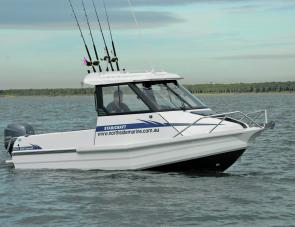
Portrait of a serious fishing boat. The Stabicraft 2050 Super Cab’s lines are shown to their best advantage.
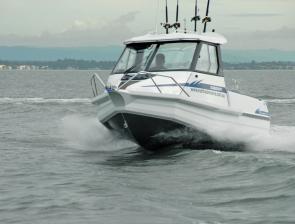
Wide spray chines formed by the craft’s pontoons kick spray well down away from the hull, as seen here under way.
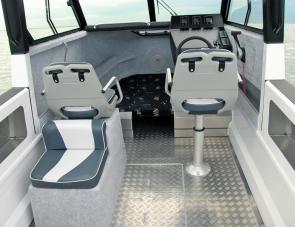
The Super Cab offers a very clean and uncluttered forward area for maximum comfort of those aboard. The big side pockets nearly start at the seating.
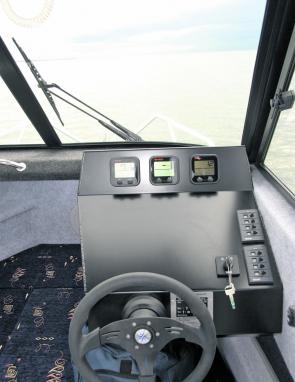
Stabicraft have provided ample room on the 2050’s dash for nav aids and big sounder screens.
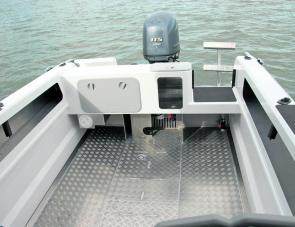
The ample cockpit and wash out tread plate floor are key fishing features.
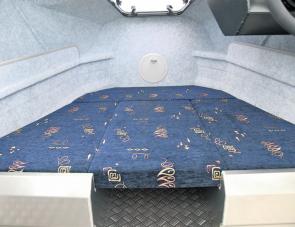
The lined cabin is in the deluxe class with a well-cushioned vee berth and abundant side shelving.
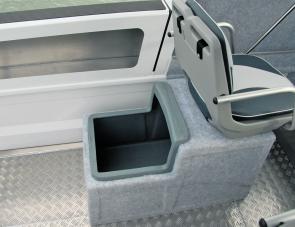
Removing the seat squab provides access to a handy additional storage area situated under the rear facing seat to port.

A Dunbier dual axle trailer made easy work of launching and retrieval of the solid Stabicraft.
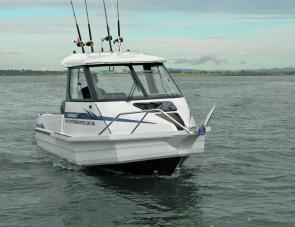
Raft-like stability is a feature of this craft because of the outer pontoon section prevents any leaning.




